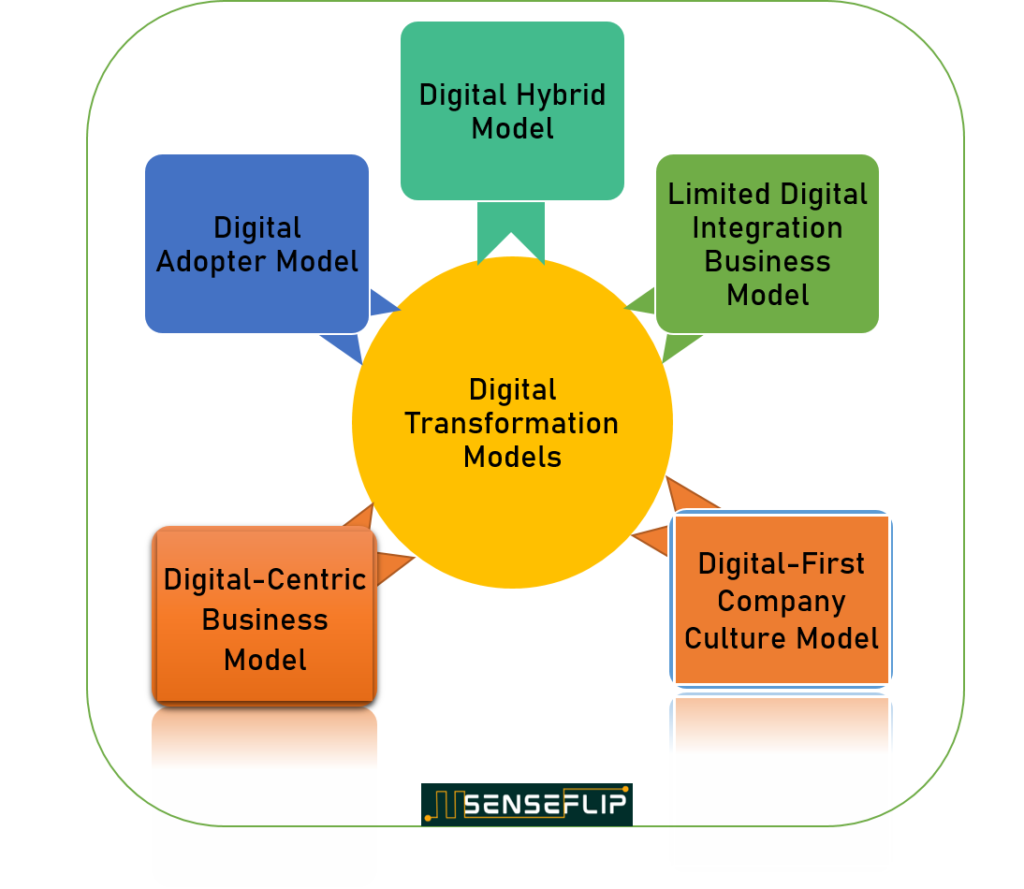
The digital transformation model is a roadmap that companies follow to embrace the power of digital technologies and revolutionize their business. It’s like giving your organization a tech-savvy makeover to enhance everything from operations to customer experiences!
A company decides to embark on a digital transformation journey. They want to leverage cutting-edge digital tools, Artificial Intelligence and strategies to take their business to new heights. So, what’s the game plan? They turn to digital transformation models!
Now, these models aren’t the kind you find strutting on runways, but they sure can make your business walk the walk of success. These frameworks provide a step-by-step guide to integrating digital technologies seamlessly and implementing smarter processes. The ultimate goal? To boost efficiency, enhance customer satisfaction, and achieve outstanding business outcomes!
In the era of digital transformation, companies can be categorized based on the digital transformation models they adopt. These models represent different approaches and strategies that companies use to leverage digital technologies and processes to improve their business operations and deliver value to customers.
Digital Transformation Models, Along with Examples and Explanations:

Digital-Centric Business Model
The digital-centric business model is a powerful digital transformation model characterized by a strong emphasis on digital technologies as the foundation of the company’s operations. This approach allows businesses to leverage the power of technology to transform the way they deliver products and services, engage with customers, and optimize internal processes.
Here are some examples of companies that follow the digital-native model:
Amazon: Amazon is a prime example of a digital-centric business. It started as an online bookstore but quickly expanded its offerings to become the world’s largest online retailer. Amazon revolutionized the retail industry by leveraging digital channels to offer a vast selection of products, convenient delivery options, and personalized recommendations based on user data. Their use of advanced data analytics and AI-driven insights allows them to understand customer preferences better and optimize their supply chain, making them highly competitive in the e-commerce space.
Tesla: Tesla is a digital-centric automotive company that has revolutionized the electric vehicle market. They design their cars with cutting-edge technology, featuring sophisticated infotainment systems and over-the-air updates for improved functionality. Tesla leverages data from its vehicles to gather insights on performance, safety, and user behavior, allowing them to make data-driven decisions for product enhancements and future innovations.
Airbnb: Airbnb disrupted the hospitality industry by creating a digital platform that allows individuals to rent out their properties to travelers. They have built an ecosystem where hosts and guests can interact directly through their website and app, cutting out the need for traditional intermediaries. Through digital channels, Airbnb can collect reviews and feedback, ensuring trust and safety in their community. Their data-driven approach helps them effectively improve their service offerings and cater to customer preferences.
These examples illustrate how digital-centric companies disrupt industries by using digital transformation model as a strategic advantage. They redefine customer experiences, streamline operations, and use data-driven insights to innovate continuously. As a result, they have become some of the most successful and influential companies in their respective domains
Digital-First Company Culture Model
A digital-first company culture is characterized by a mindset that prioritizes and embraces digital solutions across all aspects of the organization. This cultural model fosters agility, innovation, and a willingness to experiment with new disruptive technologies to gain a competitive edge.
Let’s explore this further with some examples of companies that embody a digital-first culture in terms of digital transformation model:
Google: Google is renowned for its digital-first approach, deeply embedded in its company culture. Employees are encouraged to use digital tools and platforms to collaborate, communicate, and share information efficiently.
The company’s “20% time” policy allows employees to spend a portion of their work hours on personal projects, which often leads to the development of innovative digital solutions and products. Google’s culture of experimentation and continuous improvement has led to numerous successful digital ventures beyond its core search engine, such as Google Maps, Google Drive, and Google Photos.
Adobe: Adobe is a software company that has embraced a digital-first culture to drive innovation in the creative industry. Their creative software, including Photoshop and Illustrator, has become industry standards.
Adobe continually updates its products based on user feedback and technological advancements, ensuring that its solutions remain at the forefront of the digital creative landscape. Additionally, Adobe’s transition to a subscription-based model through Adobe Creative Cloud showcases its commitment to providing continuous digital updates and improvements.
In these examples, we can see how a digital-first company culture drives innovation, agility, and responsiveness to customer needs. By prioritizing digital solutions and staying open to experimentation, these companies can continuously evolve and maintain a competitive advantage in the ever-changing digital landscape.
Limited Digital Integration Business Model
A limited digital integration business model refers to companies that have not fully embraced digital elements as a core part of their operations. These businesses may have a traditional approach to delivering products or services and may not leverage digital technologies to their fullest potential.
Let’s explore this further with some examples:
Brick-and-Mortar Banks: While many banks have started to embrace digital transformation, some smaller brick-and-mortar banks may still have a limited digital integration business model. They might lack robust online banking platforms, mobile apps, or advanced digital financial services that larger, more digitally focused banks offer.
Local Retail Stores: Many small, local retail stores, especially in less digitally mature markets, might have a limited digital integration model. These stores primarily rely on in-person foot traffic and traditional advertising methods rather than building a strong online presence. They may not offer e-commerce options, and their customer interactions might be limited to physical stores or phone calls.
These examples demonstrate that limited digital integration does not mean these businesses are entirely devoid of digital elements, but they might not fully leverage digital technologies to drive their core operations or customer interactions. Such companies might face challenges in reaching tech-savvy customers or may miss out on opportunities for process optimization and cost efficiencies that digital transformation can offer.
As the business landscape continues to evolve, these companies may eventually find it beneficial to explore digital strategies and enhance their digital integration to stay competitive and relevant in the market.
Digital Adopter Model
The digital adopter model refers to companies that proactively embrace digital technologies and strategies, recognizing their significance in the modern business landscape. While these companies may not be leading the way in digital transformation, they actively work to integrate digital elements into their operations to improve efficiency, enhance customer experiences, and stay competitive.
Here are some examples of companies following the digital adopter model:
McDonald’s: McDonald’s is a global fast-food chain that has embraced digital adoption to enhance its customer experience and streamline operations. The company introduced self-order kiosks in many of its locations, allowing customers to place their orders electronically.
They also offer a mobile app for ordering and delivery services, making it convenient for customers to access their products. By adopting these digital elements, McDonald’s has been able to improve order accuracy, reduce wait times, and cater to the preferences of tech-savvy customers.
Walmart: Walmart is a retail giant that has actively adopted digital strategies to compete in the e-commerce space. They invested in their online platform, offering a wide range of products through their website and mobile app. Walmart also introduced various digital fulfillment options, such as in-store pickup and same-day delivery, to provide customers with flexible choices.
Through these digital efforts, Walmart has been able to expand its customer reach beyond physical stores and compete with other e-commerce giants.
In the digital adopter model, these companies understand the importance of digitalization and actively invest in digital technologies and strategies to improve their business processes and customer interactions. While they may not be at the cutting edge of digital transformation, their willingness to adopt digital elements positions them well to remain competitive and relevant in the digital age.
Digital Hybrid Model
The digital hybrid model is a strategic approach that combines digital technologies and strategies with traditional methods in a balanced manner. Companies following this model recognize that a one-size-fits-all approach may not be suitable for their unique business needs and customer preferences. Instead, they integrate digital elements where they bring the most value while continuing to leverage traditional methods where they remain effective.
Here are some examples of how companies adopt the digital hybrid model:
Education Sector: Educational institutions often adopt the digital hybrid model to cater to diverse learning preferences. They incorporate digital learning platforms and tools to offer online courses and resources. Simultaneously, they continue to offer in-person classes and traditional textbooks for students who prefer a more traditional approach to learning.
Healthcare Providers: In the healthcare industry, some providers implement the digital hybrid model by offering telehealth services alongside traditional in-person appointments. Patients can choose to consult with healthcare professionals through video calls or opt for face-to-face consultations based on their convenience and medical needs.
Advertising and Marketing: Advertising agencies and marketing firms employ the digital hybrid model by blending traditional advertising methods, such as billboards and print ads, with digital advertising channels, including social media campaigns and online ads. This allows them to reach a wider audience and target specific demographics effectively.
The digital hybrid model allows companies to take advantage of the benefits offered by digital technologies while ensuring that they do not completely replace traditional methods that still hold value for certain aspects of their business.
This approach enables companies to strike a balance between innovation and continuity, providing a cohesive and adaptable approach to digital transformation that aligns with their business goals and customer preferences.
Conclusion
In conclusion, digital transformation model is an ongoing and essential process that empowers businesses and industries to adapt, innovate, and thrive in a rapidly changing world. By embracing digital technologies and a customer-centric approach, organizations can optimize their operations, provide better products and services, and remain competitive in their respective markets.
The examples provided demonstrate how digital transformation model is reshaping various sectors, improving efficiency, accessibility, and overall user experiences. As we move forward, digital transformation will continue to be a driving force behind innovation, shaping the way we live, work, and interact in the future.
